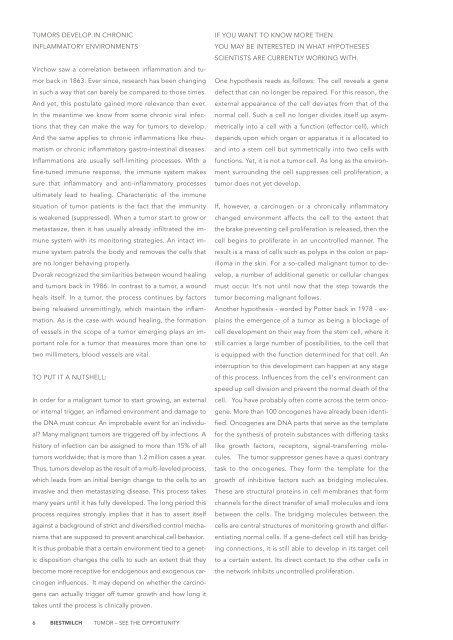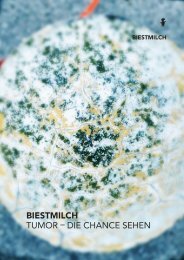Tumor – see the opportunity
Susann Kraeftner, MD – If you would like to pluck up the courage to make your own decisions; if you don‘t want to let the opinions of others make you doubtful, those presented to you in the outside world and inside clinics and health care centers, inside the territories of science where one believes to have entered the realm of truth, if you have realized for yourself that the only right way is the way you have chosen for yourself, then give in to reading the next pages. If you have questions feel free to ask www.biestmilch.com/helpdesk
Susann Kraeftner, MD – If you would like to pluck up the courage to make your own decisions; if you don‘t want to let the opinions of others make you doubtful, those presented to you in the outside world and inside clinics and health care centers, inside the territories of science where one believes to have entered the realm of truth, if you have realized for yourself that the only right way is the way you have chosen for yourself, then give in to reading the next pages. If you have questions feel free to ask www.biestmilch.com/helpdesk
Create successful ePaper yourself
Turn your PDF publications into a flip-book with our unique Google optimized e-Paper software.
TUMORS DEVELOP IN CHRONIC<br />
inflammatory ENVIRONMENTS<br />
Virchow saw a correlation between inflammation and tumor<br />
back in 1863. Ever since, research has been changing<br />
in such a way that can barely be compared to those times.<br />
And yet, this postulate gained more relevance than ever.<br />
In <strong>the</strong> meantime we know from some chronic viral infections<br />
that <strong>the</strong>y can make <strong>the</strong> way for tumors to develop.<br />
And <strong>the</strong> same applies to chronic inflammations like rheumatism<br />
or chronic inflammatory gastro-intestinal diseases.<br />
Inflammations are usually self-limiting processes. With a<br />
fine-tuned immune response, <strong>the</strong> immune system makes<br />
sure that inflammatory and anti-inflammatory processes<br />
ultimately lead to healing. Characteristic of <strong>the</strong> immune<br />
situation of tumor patients is <strong>the</strong> fact that <strong>the</strong> immunity<br />
is weakened (suppressed). When a tumor start to grow or<br />
metastasize, <strong>the</strong>n it has usually already infiltrated <strong>the</strong> immune<br />
system with its monitoring strategies. An intact immune<br />
system patrols <strong>the</strong> body and removes <strong>the</strong> cells that<br />
are no longer behaving properly.<br />
Dvorak recognized <strong>the</strong> similarities between wound healing<br />
and tumors back in 1986. In contrast to a tumor, a wound<br />
heals itself. In a tumor, <strong>the</strong> process continues by factors<br />
being released unremittingly, which maintain <strong>the</strong> inflammation.<br />
As is <strong>the</strong> case with wound healing, <strong>the</strong> formation<br />
of vessels in <strong>the</strong> scope of a tumor emerging plays an important<br />
role for a tumor that measures more than one to<br />
two millimeters, blood vessels are vital.<br />
TO PUT IT A NUTSHELL:<br />
In order for a malignant tumor to start growing, an external<br />
or internal trigger, an inflamed environment and damage to<br />
<strong>the</strong> DNA must concur. An improbable event for an individual?<br />
Many malignant tumors are triggered off by infections. A<br />
history of infection can be assigned to more than 15% of all<br />
tumors worldwide; that is more than 1.2 million cases a year.<br />
Thus, tumors develop as <strong>the</strong> result of a multi-leveled process,<br />
which leads from an initial benign change to <strong>the</strong> cells to an<br />
invasive and <strong>the</strong>n metastasizing disease. This process takes<br />
many years until it has fully developed. The long period this<br />
process requires strongly implies that it has to assert itself<br />
against a background of strict and diversified control mechanisms<br />
that are supposed to prevent anarchical cell behavior.<br />
It is thus probable that a certain environment tied to a genetic<br />
disposition changes <strong>the</strong> cells to such an extent that <strong>the</strong>y<br />
become more receptive for endogenous and exogenous carcinogen<br />
influences. It may depend on whe<strong>the</strong>r <strong>the</strong> carcinogens<br />
can actually trigger off tumor growth and how long it<br />
takes until <strong>the</strong> process is clinically proven.<br />
IF YOU WANT TO KNOW MORE THEN<br />
YOU MAY BE interested IN WHAT HYPOTHESES<br />
SCIENTISTS ARE CURRENTLY WORKING WITH.<br />
One hypo<strong>the</strong>sis reads as follows: The cell reveals a gene<br />
defect that can no longer be repaired. For this reason, <strong>the</strong><br />
external appearance of <strong>the</strong> cell deviates from that of <strong>the</strong><br />
normal cell. Such a cell no longer divides itself up asymmetrically<br />
into a cell with a function (effector cell), which<br />
depends upon which organ or apparatus it is allocated to<br />
and into a stem cell but symmetrically into two cells with<br />
functions. Yet, it is not a tumor cell. As long as <strong>the</strong> environment<br />
surrounding <strong>the</strong> cell suppresses cell proliferation, a<br />
tumor does not yet develop.<br />
If, however, a carcinogen or a chronically inflammatory<br />
changed environment affects <strong>the</strong> cell to <strong>the</strong> extent that<br />
<strong>the</strong> brake preventing cell proliferation is released, <strong>the</strong>n <strong>the</strong><br />
cell begins to proliferate in an uncontrolled manner. The<br />
result is a mass of cells such as polyps in <strong>the</strong> colon or papilloma<br />
in <strong>the</strong> skin. For a so-called malignant tumor to develop,<br />
a number of additional genetic or cellular changes<br />
must occur. It‘s not until now that <strong>the</strong> step towards <strong>the</strong><br />
tumor becoming malignant follows.<br />
Ano<strong>the</strong>r hypo<strong>the</strong>sis - worded by Potter back in 1978 - explains<br />
<strong>the</strong> emergence of a tumor as being a blockage of<br />
cell development on <strong>the</strong>ir way from <strong>the</strong> stem cell, where it<br />
still carries a large number of possibilities, to <strong>the</strong> cell that<br />
is equipped with <strong>the</strong> function determined for that cell. An<br />
interruption to this development can happen at any stage<br />
of this process. Influences from <strong>the</strong> cell‘s environment can<br />
speed up cell division and prevent <strong>the</strong> normal death of <strong>the</strong><br />
cell. You have probably often come across <strong>the</strong> term oncogene.<br />
More than 100 oncogenes have already been identified.<br />
Oncogenes are DNA parts that serve as <strong>the</strong> template<br />
for <strong>the</strong> syn<strong>the</strong>sis of protein substances with differing tasks<br />
like growth factors, receptors, signal-transferring molecules.<br />
The tumor suppressor genes have a quasi contrary<br />
task to <strong>the</strong> oncogenes. They form <strong>the</strong> template for <strong>the</strong><br />
growth of inhibitive factors such as bridging molecules.<br />
These are structural proteins in cell membranes that form<br />
channels for <strong>the</strong> direct transfer of small molecules and ions<br />
between <strong>the</strong> cells. The bridging molecules between <strong>the</strong><br />
cells are central structures of monitoring growth and differentiating<br />
normal cells. If a gene-defect cell still has bridging<br />
connections, it is still able to develop in its target cell<br />
to a certain extent. Its direct contact to <strong>the</strong> o<strong>the</strong>r cells in<br />
<strong>the</strong> network inhibits uncontrolled proliferation.<br />
6<br />
BIESTMILCH<br />
<strong>Tumor</strong> <strong>–</strong> <strong>see</strong> <strong>the</strong> <strong>opportunity</strong>










